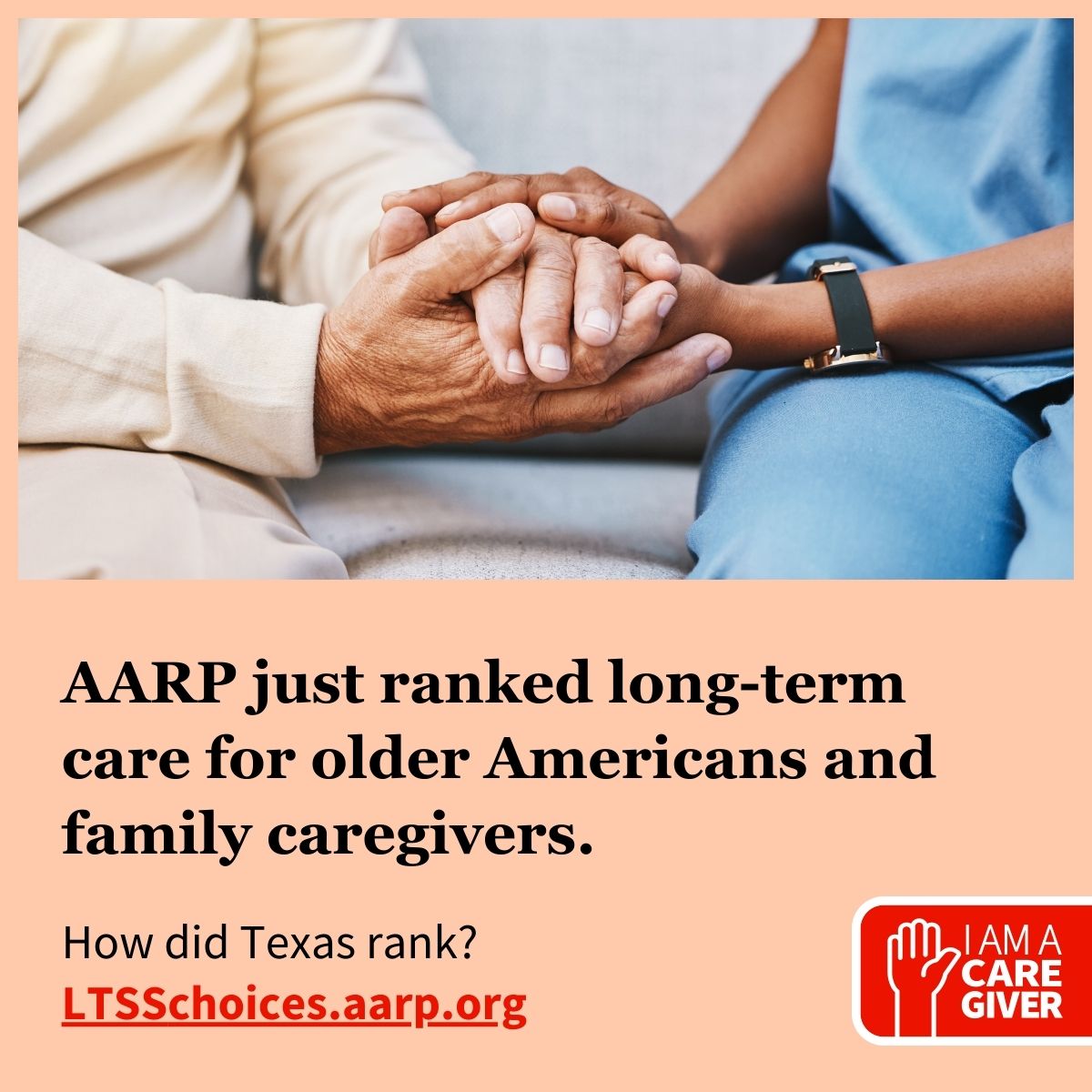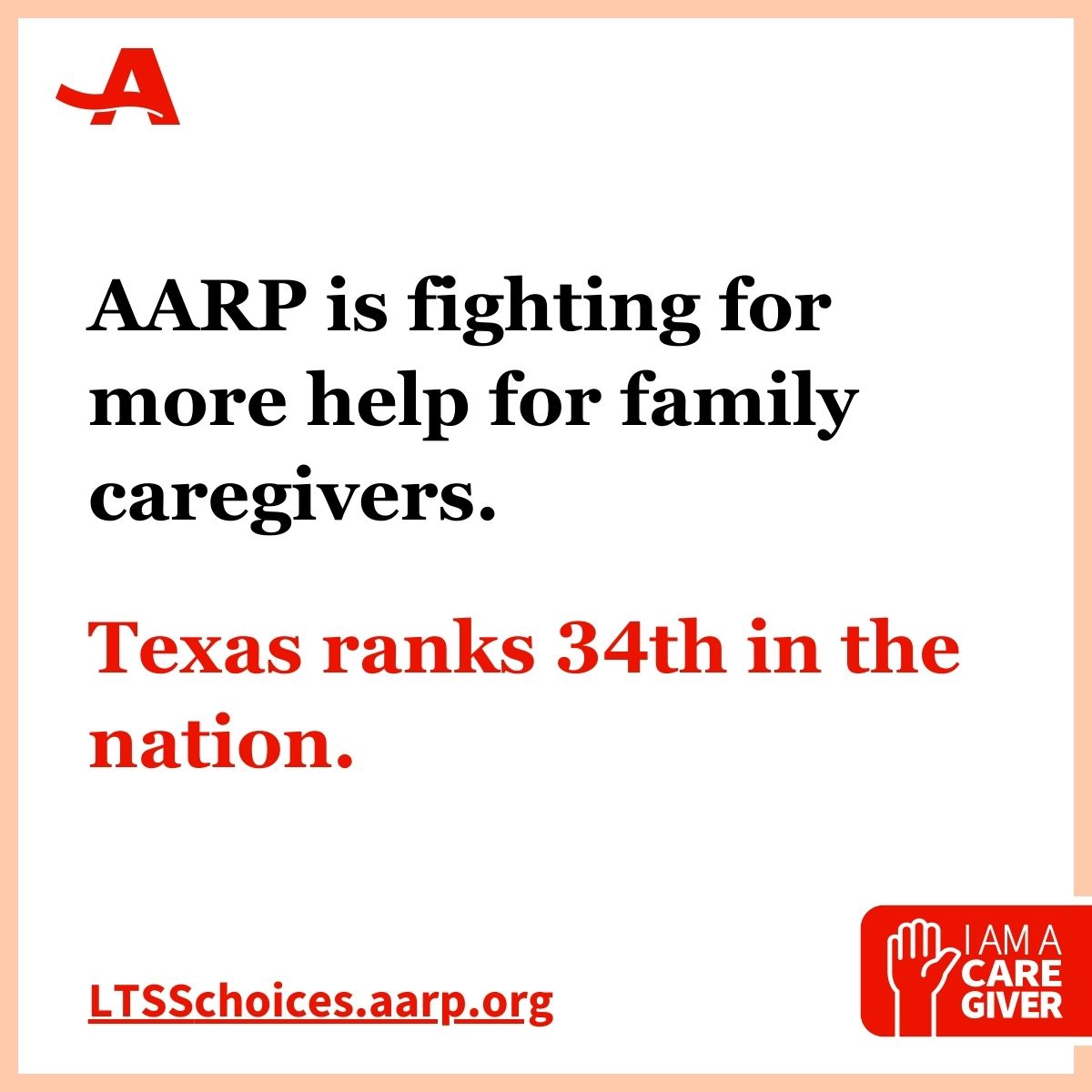AARP Hearing Center
AUSTIN, Texas – AARP’s new Long-Term Services and Supports (LTSS) Scorecard finds that more than three years after the COVID-19 pandemic began, care provided in the United States for older adults and people with disabilities is painfully inadequate. The report finds that major gaps persist in every state, including Texas, especially related to nursing homes and support for family caregivers.
Ranking #34 in the country, Texas still has much more to do to keep up with the rapidly changing needs of an aging population.
“The pandemic reinforced the need to strengthen long-term care for countless loved ones across the country, including in Texas,” said AARP Texas Director Tina Tran. “AARP’s Scorecard shows that there are many roads to meet the needs of all Texans who deserve the very best care, including the 3.1 million family caregivers in our state. It’s time to accelerate our efforts, for the sake of saving more lives.”
Key findings include:
Nursing Homes and Institutional Care
· A major workforce crisis exists in nursing home care. Across all states, wages for direct care workers are lower than wages for comparable occupations, with shortfalls ranging from $1.56 to $5.03 per hour. In Texas, wages are $4.33 lower than other entry level jobs.
o Nationally, more than half of nursing staff in nursing homes leave their job within a year (53.9% turnover rate). In Texas, the rate is above the average, at 59.7%.
o Staffing disparities are a significant challenge. Residents of nursing homes with high admissions of Black residents receive almost 200 fewer hours of care per year compared to residents of nursing homes with high admissions of white residents.
· Nationally, only 22% of nursing home residents live in a facility with a 5-star rating; about 7.4% of Texas residents live in a 5-star facility. Gaps in workforce and equity result in persistent problems in care. For instance, about 10% of nursing home residents nationwide experienced a pressure sore. Pressure sores can be life-threatening as they can lead to bone or joint infections, cancer, and sepsis.
· Only nine states have enhanced hazard mitigation plans for natural disasters and other emergencies to address the needs of vulnerable older adults and people with disabilities, including for nursing home residents.
· There is some progress toward innovative and effective alternatives to traditional nursing home models. For instance, 10 states made strides in nursing home innovations, such as by supporting Green House® Nursing Home availability and policies, which includes small facilities, private rooms, and other best practices.
Family Caregiving
· Only six states provide a tax credit for family caregivers’ out-of-pocket expenses. Family caregivers on average spend $7,242 per year on out-of-pocket costs.
· Only seven states have statewide laws protecting caregivers from discrimination in the workplace that ensure they are not unfairly treated due to caregiving duties outside of work.
· Twelve states have enacted paid family leave laws and 18 states have paid sick day laws, which can be used for caregiving.
· Dozens of states experienced declines in the number of care choices that help support families managing caregiving. For instance, 21 states experienced declines of 10% or more in adult day services since 2016, and 16 states, had declines of 10% or more in access to home health aides since 2019.
Recommendations
Key recommendations from the report and AARP to strengthen support for long-term care and aging at home:
· Prioritizing saving time, money, and increasing support for the 48 million family caregivers, who are the backbone of the long-term care system, providing over $600 billion in unpaid care, such as with paid leave, tax credits, and other mechanisms to address health and financial needs.
· Investing in all aspects of Home and Community-Based Care infrastructure, such as increasing support and training for home health aides and home visits, supporting the ability to access and use medical devices and equipment, and updating key Medicaid regulations and payment models.
· Bolstering the nursing home and in-home care workforce, with improved recruitment and training, increasing pay, and expanding the ability of trained nurses, aides, community health workers and other paraprofessionals to take on some aspects of care. States can choose to enact and enforce staffing and related care standards.
· Expanding the use of innovative, effective models for nursing homes can improve both quality of care and quality of life, such as with smaller facilities and private rooms.
· Addressing inequities by investing to close the staggering gaps in access to quality care and facilities and staffing shortages.
· Building multisector plans for aging, coalitions and age-friendly health systems, and consider the wider needs to allow individuals to live independently in their homes and communities, such as having affordable and accessible housing and transportation, improved community design, and comprehensive emergency preparedness plans.
· Advancing innovation in cities, counties and states by supporting comprehensive state- and community-wide aging plans and piloting new approaches and programs, like Green House® Nursing Homes and presumptive eligibility, that can then be scaled.
· Ensuring every state in the nation has a sound emergency preparedness plan to support nursing home residents, in particular, in times of crisis – including natural disaster.
The Scorecard includes a series of 50 indicators focused on 1) affordability and access; 2) choice of setting and provider; 3) safety and quality; 4) support for family caregivers; and 5) community integration, using data from a variety of publicly available sources, such as the Centers for Medicaid and Medicare Services, American Community Survey, and Bureau of Labor Statistics.
The LTSS Scorecard is funded by AARP Foundation with the support of The SCAN Foundation, The Commonwealth Fund, and The John A. Hartford Foundation and has been updated every three years since 2011.
To view the full Scorecard and state-by-state information visit www.ltsschoices.aarp.org.
State Rankings:
· Tier One: 1: Minnesota; 2: Washington state; 3: District of Columbia; 4: Massachusetts; 5: Colorado.
· Tier Two: 6: New York; 7: Oregon; 8: Hawaii; 9: Vermont; 10: New Jersey; 11: California; 12: Rhode Island; 13: Connecticut; 14: Maryland; 15: Wisconsin; 16: Maine.
· Tier Three: 17: Delaware; 18: Nebraska; 19: North Dakota; 20: New Mexico; 21: Pennsylvania; 22: Arizona; 23: Iowa; 24: New Hampshire; 25: Illinois; 26: Alaska; 27: Indiana; 28: Virginia; 29: Utah; 30: Kansas; 31: Michigan; 32: Ohio; 33: Montana; 34: Texas; 35: Idaho.
· Tier Four: 36: South Dakota; 37: Arkansas; 38: Missouri; 39: Georgia; 40: Wyoming; 41: North Carolina; 42: Kentucky; 43: Florida: 44: Nevada; 45: Louisiana; 46: Oklahoma.
· Tier Five: 47: Tennessee; 48: Mississippi; 49: South Carolina; 50: Alabama; 51: West Virginia.
###
About AARP
AARP is the nation’s largest nonprofit, nonpartisan organization dedicated to empowering people 50 and older to choose how they live as they age. With nearly 38 million members, including more than 2.3 million in Texas, AARP works to strengthen communities and advocates for what matters most to families: health security, financial stability and personal fulfillment.
For Media Inquiries About This News Release:
Contact: Mark Hollis, mhollis@aarp.org, 512.480.2429 or (cell) 512.574.3739

































































